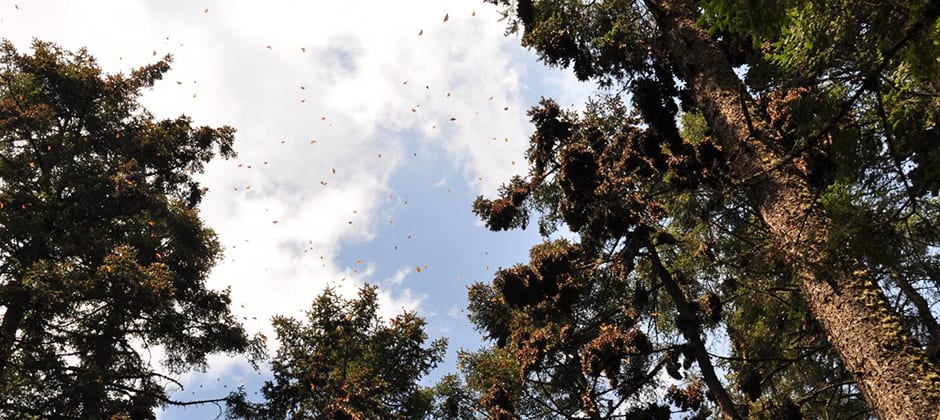Share this article
Watch: Temperature drives internal clock for monarchs
When monarch butterflies overwinter in central Mexico and along the California coast, they spend much of the time dormant to help with their winter survival before reproduction.
Researchers recently found temperature plays an important role in driving the internal clock that tells the monarchs (Danaus plexippus) when it’s time to leave that dormant state — called diapause — in order to mate and migrate back north.
“It’s a common story told that it’s the warming in the spring and the long days of spring that rouses monarchs out of diapause,” said D. André Green, President’s Postdoctoral Fellow at the University of Michigan and lead author of the study published in Molecular Ecology. But Green came across a paper published in the 1980s that told a different story — monarchs were coming out of their diapause in the middle of winter. “That initially surprised me,” Green said.
So Green set up an experiment that mirrored the one that he came across, but he added some additional aspects such as molecular analyses. He collected female monarchs at overwintering sites in central California in November, after they entered diapause, and he brought them back to a lab in Chicago. There, in an experimental chamber, he approximated the temperatures and day lengths that occur in central California during November.
Then, Green went back to the same overwintering sites in December and then again in January, captured more female monarchs and brought those back to the lab. These monarchs were experiencing cooler temperatures.
The next step was to determine which butterflies were in diapause and which ones weren’t. Green said the way to tell was to look at the number of eggs in females — a large number of mature eggs means that females have terminated diapause.
Green and his colleagues determined that compared to the monarchs collected in November, the ones collected in December had more reproductive development, suggesting they had finished diapause. This result demonstrated that a condition at the overwintering site — likely cold temperature — terminated diapause early.

Researcher D. André Green holds a monarch butterfly in an outdoor insectary at the University of Michigan’s Matthaei Botanical Gardens. ©Daryl Marshke, Michigan Photography
On the other hand, the monarchs in the artificial chamber in the lab or from the wild showed the exact same reproductive condition in January.
Green said this means that the butterflies have an internal timer, which seems to be more strongly controlled by temperature, not light.
The team then conducted molecular analyses looking at gene expression of the different monarchs to understand better how the internal timer works. Their findings suggest that epigenetic changes, or chemical modifications to DNA-associated proteins that control gene expression, may be the timing mechanism. Their study also suggested a link between calcium in the butterflies’ heads and cryoprotectants — which prevents freezing — during cold weather, which may provide a link between cold weather and the butterflies’ timer, he said.
“The molecular analyses very much corroborated the idea that it was cold that was bringing monarchs out of diapause earlier,” Green said. “This is a counterintuitive idea because generally cold is known to slow down developmental processes and metabolism. The study is one of the first to be able to provide a molecular mechanism for this seemingly counterintuitive result. That was pretty exciting.”
Green said this may have implications for monarch conservation in the face of climate change. Researchers already know that it can be too warm for monarchs, causing them to go through their fat storage quickly in their overwintering sites. But, he said, “an interesting implication from this study is that cold can change when monarchs are going to come out of their diapause.”
Diapause gets the butterflies ready for the upcoming spring, and coming out of diapause early can be a problem.
The next step is to take a deeper look at how the internal timer works, Green said.
“I think it will give us a better idea of exactly the environment they’re potentially looking for,” he said. “So in that case we’ll have another clue about what specific environment we should protect.”
See more about Green’s study of butterfly migrations here:
Header Image: Monarch butterflies overwinter in central Mexico. ©D. André Green








